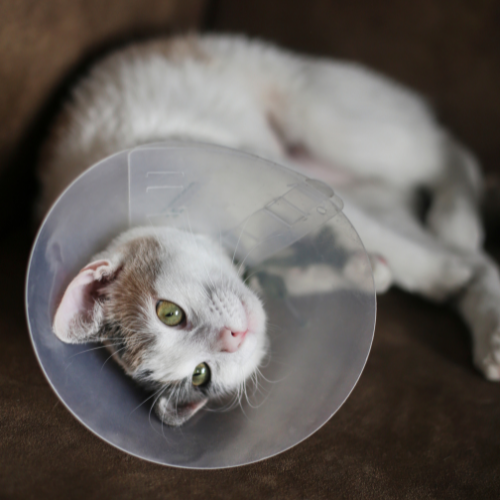Blocked Cat
What is a “blocked cat”?
The fancy term for a “blocked cat” is feline lower urinary tract obstruction. This means the urethra (the tube that runs from the bladder to the outside world) is blocked. When this tube is blocked, your cat can’t pee. They will probably try, but it’s a losing battle. And it hurts. A lot. It is also a life-threatening emergency because if your cat doesn’t empty their bladder, the bladder will get bigger and bigger, to the stage where it might rupture! Acute kidney failure and death can occur within a couple of days if not managed in a timely manner.
What are the signs of a “blocked cat”?
Your cat might be blocked if you’ve noticed that they:
- haven’t peed in a while. This depends on your cat (e.g. they use the litter twice a day but haven’t used it at all today!) AND
- is sitting in the litter box frequently and straining to urinate (with only small amounts or drops of urine coming out)
- is meowing/crying with discomfort like the world is ending
- doesn’t seem interested in food and water, may also be vomiting
These clinical signs may also be commonly seen in cats with other urinary issues such as a feline urinary tract infection or feline idiopathic cystitis. Treatment will be guided by the underlying cause so it is important to have your vet check your cat out to determine which condition we may be dealing with.

What causes a “blocked cat”?
A “blocked cat” occurs predominantly in male cats (although can occur in female cats on rare occasions) and that is because their urethra is much longer and narrower compared to a female.
An obstruction can occur due to the one of the following:
- A ‘plug’ in the urethra – often made of an accumulation of mineral crystals, protein (mucous), red blood cells, white blood cells and other debris within the bladder
- A small bladder stone (urolith) or an accumulation of multiple little stones
- Swelling and spasm of the urethra due to bladder inflammation preventing your cat from relaxing the muscle around the urethra (urethral sphincter muscle)
I think my cat is “blocked”! What should I do?
Call your vet and bring your cat in to see a veterinarian ASAP! We’ll assess them to determine if they are actually blocked or suffering from a different condition with similar signs like feline urinary tract infection or feline idiopathic cystitis. If they are indeed blocked, this is an EMERGENCY! Not only is it really, really painful, your cat can develop heart problems (due to electrolyte imbalances), kidney problems, and go into shock. With too much pressure, the bladder can burst and urine will leak into the abdomen and this is often fatal.
Treatment for a “blocked cat”
Unblocking your cat is a surgical procedure and the initial aim is to relieve the obstruction as soon as possible. They will be placed under general anaesthetic and imaging (usually x-rays) are performed to help identify the underlying cause of the obstruction and determine the best treatment method. A urinary catheter (a flexible tube) is passed into the bladder to remove the blockage and allow for urine to flow freely. We will often leave the catheter in for a few days, so the urine can pass while your cat recovers.
Your cat will usually be in hospital for a few days, so they can stay on IV fluids with lots of medication especially pain relief and some anti-spasmodics. The IV fluids will help flush out all the toxins and yucky stuff while also keeping them hydrated. It also helps us correct any electrolyte imbalances (especially potassium) that might have occurred while they were blocked.
If your cat has suffered from being blocked, there’s a high chance that he/she might be blocked again. If this happens frequently enough, we might talk to you about a surgical procedure called a perineal urethrostomy. This is a surgery which is usually performed on male cats where the penis is removed and a new hole opening created to reduce the risk of obstruction.
How can I reduce the risk of my cat getting “blocked”?err
Some common risk factors that make certain cats more likely to become “blocked” include:
- Stress – There is a lot of evidence to indicate stress can play a big role in cats developing feline idiopathic cystitis (inflammation of the bladder wall). The goal is to keep their environment as stress-free as possible. If your cat is particularly stressy, a Feliway diffuser may be a good first line choice as it contains feel-good chemical signs (pheromones) that help comfort and reassure cats and kittens. Moving houses, boarding with a pet sitter, or bringing in a new addition to the family can all be very stressful events for your cat! For some particularly stressful cats, it would be worth speaking to your vet about anti-anxiety medications (e.g. gabapentin, fluoxetine, etc.) for the short or long term.
- Overweight – Chubby cats are more likely to become “blocked” so it is important to maintain a target weight for your cat, especially if they are a male cat.
- Dietary modifications – If your cat has suffered from a urinary blockage before, there’s a good chance we’ve recommended your cat a special diet. This all depends on the main cause of the urinary blockage. A prescription diet like Hill’s c/d (Urinary Care) Multicare or Royal Canin Urinary S/O can make a world of difference, and contains ingredients that can reduce stress and/or help prevent crystal formation.
- Supplements – Just like how there are supplements for joint health and gut health, there are also ones designed for urinary health. Cystophan is a daily nutritional supplement that can be given to cats to reduce the risk of feline idiopathic cystitis by supporting the protective layer of the bladder lining and containing tryptophan, an amino acid key to producing more serotonin (or happy hormones).


